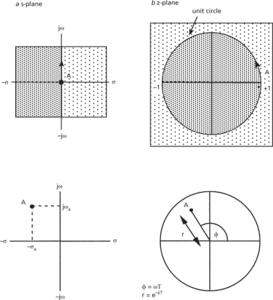An extension to the Fourier and Laplace transforms for sampled-data signals. The Laplace transform G(s) of a sampled-data signal x(t) is given by:
where s is the complex operator σ + jω (see s-domain circuit analysis) and T is the sampling period. A new variable is defined, z = esT, and the z transform G(z) of the signal x(t) becomes:
Since z = esT and s = σ + jω, then z = eσT ejωT. The term e–jωT implies a constant time delay of T seconds, and for this reason z is often referred to as the shift operator or the z transform operator.
Since z has both real and imaginary parts it can be plotted on the complex plane known as the z-plane in a similar fashion to points on the s-plane (see s-domain circuit analysis). The relationship between the s-plane and the z-plane is shown in the diagram. It can be seen that the left-hand half of the s-plane maps into the area inside the circle, called the unit circle, in the z-plane.

Z transform: relationship between (a) s-plane and (b) z-plane
- Atlantic, Battle of the
- Atlantic Charter
- Atlantic conveyor
- Atlantic Ocean
- Atlantic Period
- Atlantic Province
- Atlantic-type coast
- Atlantic-type margin
- Atlantis
- Atlantis Massif
- ATLAS
- Atlas
- atlas
- Atlas rocket
- atlas vertebra
- ATLEED
- ATLO
- ATM
- atman
- atmolysis
- atmometer
- atmophile
- atmosphere
- Atmosphere-Space Interactions Monitor
- atmospheric boundary layer